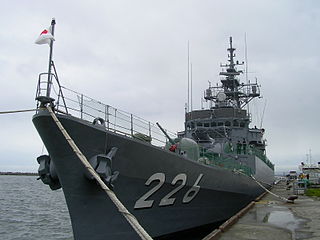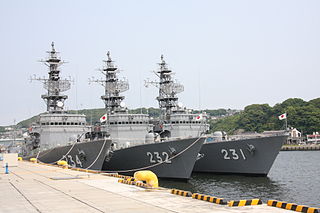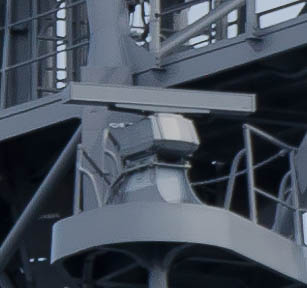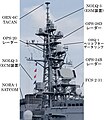
The Murasame-class destroyer is a class of destroyers, serving with the Japan Maritime Self-Defense Force (JMSDF). This is the first class of the second-generation general-purpose destroyers of the JMSDF.

The Asagiri-class destroyer is a class of destroyer, serving with the Japan Maritime Self-Defense Force (JMSDF). It was the second class of first generation general-purpose destroyers of the JMSDF.

JS Ishikari (DE-226) was the first destroyer escort with a gas turbine engine and surface-to-surface missiles of the Japanese Maritime Self-Defense Force. She is the successor of the earlier Chikugo class. Entering service in 1981, she remained active until 2007 when she was decommissioned.

The Yūbari-class destroyer escort of the Japanese Maritime Self-Defense Force is the successor of the Ishikari-class destroyer escort. Yubari was named after the experimental light cruiser of the 1920s–1930s, which served in World War II.

The Abukuma-class destroyer escort is the general-purpose destroyer escort of the Japan Maritime Self-Defense Force. It is the successor of the earlier Yūbari class.

JS Haruna (DDH-141) was the lead ship of the Haruna-class helicopter destroyer of the Japanese Maritime Self Defense Force.

Type 81 Fire Control System (FCS-2) is a Japanese shipboard gun and missile fire-control system. This series of systems has been installed on destroyers of the Japan Maritime Self-Defense Force built between FY1977 and FY2001 to control medium-caliber guns and Sea Sparrow missiles, including ESSM.

JS Hiei (DDH-142) was the second ship of the Haruna-class helicopter destroyer of the Japanese Maritime Self Defense Force.

JS Umigiri (DD-158) is an Asagiri-class destroyer of the Japan Maritime Self-Defense Force.

JS Yūbari (DE-227) was a Yūbari-class destroyer escort of the Japanese Maritime Self-Defense Force.

JS Yūbetsu (DE-228) was a Yūbari-class destroyer escort of the Japanese Maritime Self-Defense Force.

OPS-14 is a two-dimensional radar manufactured by Mitsubishi Electric. It is mainly mounted on the Maritime Self-Defense Force's self-defense ship as an anti-aircraft search radar. Variations include OPS-14B and OPS-14C.

OPS-11 is a two-dimensional radar manufactured by Mitsubishi Electric. It is installed as an anti-aircraft search radar on the Maritime Self-Defense Force's escort ship, and it will be the first model originally developed by Japan after World War II for this purpose. Variations include OPS-11B and OPS-11C.

OPS-18 is a two-dimensional radar manufactured by Japan Radio Company. It is installed as an anti-water search radar on the Maritime Self-Defense Force's escort ship. Variations include OPS-18-1 and OPS-18-3.

OPS-9 is a two-dimensional radar manufactured by Fujitsu. It is installed as an anti-water search radar on the Maritime Self-Defense Force's escort ship. Variations include OPS-9B and OPS-9C.

OPS-20 is a two-dimensional radar manufactured by Japan Radio. It is compatible with the Global Maritime Distress and Safety System (GMDSS) and installed as an anti-water search radar on the Maritime Self-Defense Force's escort ship. Variations include OPS-20B, OPS-20C and OPS-20E.

AN/SPS-6 is a two-dimensional radar manufactured by Bendix and Westinghouse Electric. It was used by the US Navy as a first-generation air-search radar after World War II, and was widely exported to allies. In addition, the improved AN/SPS-12 is the derivative types developed in other countries.

OPS-4 is a two-dimensional radar manufactured by Oki Electric Industry. It was installed as surface-search radar on the Maritime Self-Defense Force's self-defense ship.

AN/SPS-10 is a two-dimensional radar manufactured by Raytheon Technologies. It was used by the US Navy as a surface-search radar after World War II, and was equipped aboard naval ships during the Cold War. Variants include AN/SPS-10B, AN-SPS/10E and AN/SPS-10F.
























